| |
Ania's and Seth's Voyage to Not-Antarctica
Mar 1-23, 2008
|
The Valparaiso Circuit is a beautiful hike, well worth the three
days on the trail. Seth and I started the hike some 15km outside of town at a
small estancia (ranch). We took a taxi from Ushuaia, and although the
driver assured us she knew where to go as we hopped in the cab, she
started the drive by radioing for directions, and again asked the police
officer at the check point on the road out of town. The hike begins on
a dirt road through the estancia, through three or four gates, past
dogs, horses, and cows. It then climbs gently and soon becomes a series
of dissapearing and reappearing trail segments, rarely more than 100ft
each. Some of the trails bear human footprints. Others, equally
inviting, lead directly into beaver ponds and probably get more use from
these four-footed invaders than from two-footed invaders.
The trail varies immensely in footing. We trekked through squishy peat bogs,
thin forest cluttered with beaver-fallen trees, alpine fields of scree,
a bit of dense bushwhacking, and sub-alpine tundra.
|
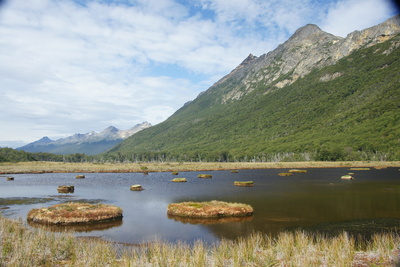
Peat bogs line the valley bottoms, at least where beavers
haven't yet made ponds. |
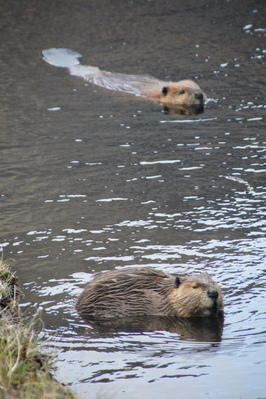
Beavers, seen along the Valparaiso Circuit. |
I call beavers "invaders" because that's what they are. In 1946, the
Argentine military released them onto the island of Tierra del Fuego.
Canada had a thriving trade in beaver pelts, and the hope was that the
Tierra del Fuego could grow its economy similarily. Unfortunately, the
milder climate resulted in beavers with less lush furs, and beaver
trapping never became profitable. Without natural or human predators,
the population has continued to grow and many of the native peat bogs in
the valley bottoms have been replaced by beaver ponds. By the end of
the hike, we were good at spotting bare tree trunks that died when their
roots were flooded, and the piles of sticks and mud that constitute each
pond's beaver lodge.
|
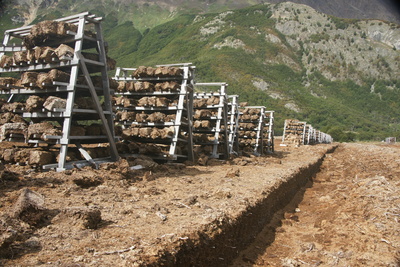
A peat excavation operation about 1 mile in along the trail.
This peat is used primarily for
resale as a supplement to potting soil. It grows only millimeters
per year. |
We returned from our hike to meet our friends Cameron and Heidi in
Ushuaia. We spent on day in the Parque Nacional Tierra del Fuego.
The next day, we boarded the ship Aleksey Maryshev chartered by
Oceanwide Expeditions to go to Antarctica. Seth and I had spent
a year preparing, buying thousands of dollars of equipment and spending
many weekends learning how to use it. This was to be the trip of the
decade.
Upon boarding, the crew
gathered all passengers and informed us that the ship had been in port
under repair for three weeks. While the mechanical problems had been
fixed, an electrical problem with one of the alarms had kept the
inspector from approving the ship to sail. The voyage was cancelled.
|
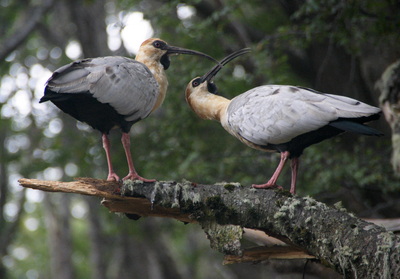
Black-faced ibises in Parque Nacional Tierra del Fuego. |
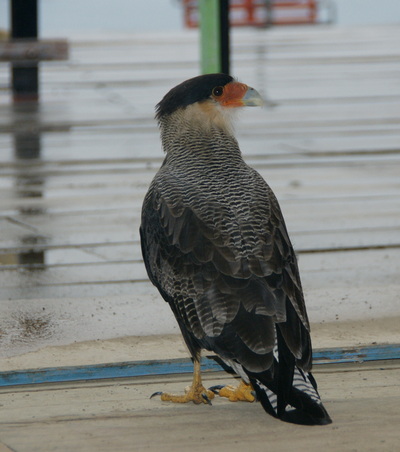
Southern Crested Caracara, staying dry at a ski lift. We hiked
here from the Hotel del Glaciar. |
With that, Oceanwide put all 46 passengers on a bus and took us to
the luxury Hotel del Glaciar, a 15 minute taxi ride from downtown Ushuaia.
We spent 3 nights here trying to avoid the $15 drinks at the hotel bar.
That was the last we saw of any Oceanwide representative, ever. One of
the passengers, Amos Nachoum of
biganimals.com,
stepped up and barely slept for the next two days as he negotiated
on behalf of the rest of us. Another
expedition, chartered by Peter Bland, would depart 2 days later, and Amos
worked to negotiate a compromise between Oceanwide and Peter Bland to
take some of the passengers from our cancelled voyage. Every few
hours, the news would change: Only the divers can go. The divers can
go only if they lend their gear to Peter's clients. Diving isn't
allowed, but snorkeling is. No snorkeling. Berths are available.
Berths aren't available. The stress of it all was too much for many,
and the Hotel del Glaciar grew emptier as folks went home or to other
vacation destinations. In the end, 15 Oceanwide passengers went
with Peter Bland, no divers among them.
|
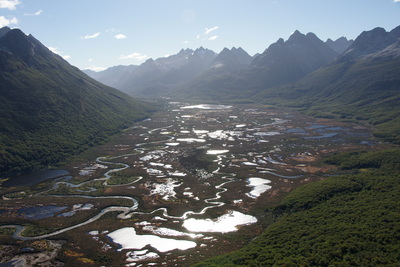
Above: View from a helicopter into the valley that forms the southern
edge of the Valparaiso Circuit. We hiked clockwise, so this
was our beginning. Right: Other views from the flight. |
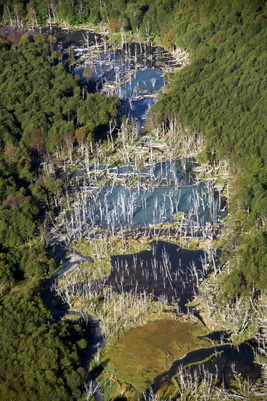
|
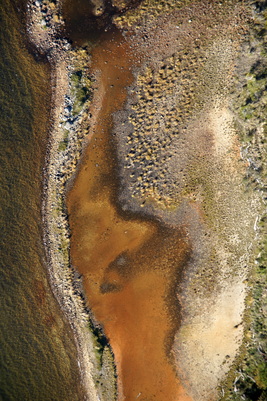
|
Nine of us set about making alternate SCUBA plans. After a few
more days in Ushuaia, we had chartered the 12-passenger yacht Santa Maria
Australis to
sail (or motor) down the Beagle Channel to where it meets the
Atlantic. Amos dropped out, having developed a nasty cold during the
stressful days at the Hotel del Glaciar. Carl dropped out, not fond
of sailing. That left seven: Harry Donenfeld and
Jeff Bozanic
(who were filming a documentary entitled
The Nautilus Effect),
Evan Bozanic (Jeff's son), Louise (Evan's grandma), Diane
(Louise's travel partner), Seth (my fiance), and me. Our crew was
Wolf (the boat owner), Carston (the captain), and Luis (the cook),
plus Carlos (the dive master).
Evan managed to get out of school for a month for this trip by
promising to educate other kids by writing
this blog
about his adventures.
|
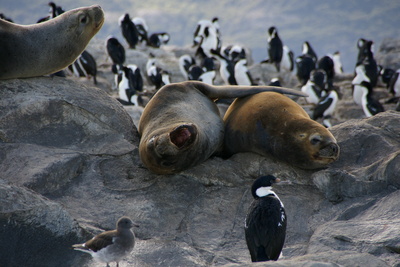
Fur seals, imperial shags (the cormorants), and a dolphin gull
on the first day of abord the Santa Maria Australis. |
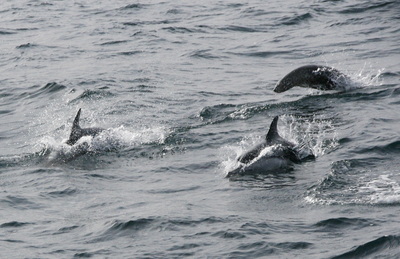
Dolphins and juvenile sea lion. We snorkeled with them, and they
swam circles around us. |
We may not have reached Antarctica, but we were tremendously lucky
with the wildlife.
We watched fur seals basking in the sun among Imperial Shags
(cormorants), and later the fur seals watched us under water.
A pod of dolphins surrounded the boat to play at the bow. We jumped
in the water with them. Harry got bumped by one zooming past his
rolling camera. In short time, a group of juvenile sea lions joined
the dolphins in jumping out of the water. I spun round and round watching
the sea lions swimming circles around me.
|
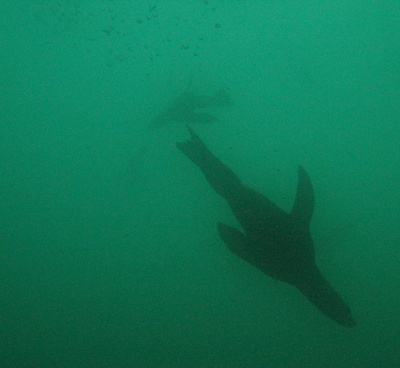
Sea lion underwater. |
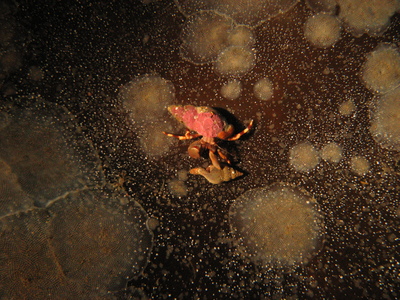
Two small crabs on kelp. The dotted blobs are something growing on
the kelp -- they seemed common in the Channel. |
Under the surface, we found fascinating invertebrate wildlife.
The species are completely different than what we see locally in
Monterey Bay (California), but seem to occupy the same ecological niches.
We saw little white starfish clinging to a meter-deep bed of kelp on a
silty bottom. There were multiple species of crabs, some either
mating or eating one another.
Fur seals came to look at us underwater,
swimming by every minute or two, closer with every pass until they
were approaching within about 3ft of us.
Strangely, we saw almost no fish.
To our disappointment, the temperature was within 1 degree of Monterey
Bay (10C), hardly the frigid waters we'd prepared for (-1C).
|
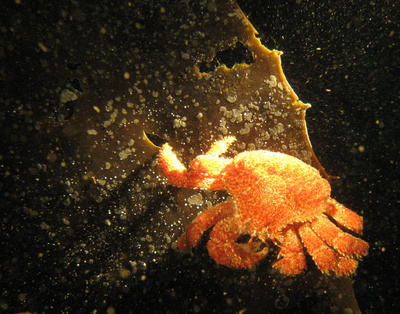
Centillon. |
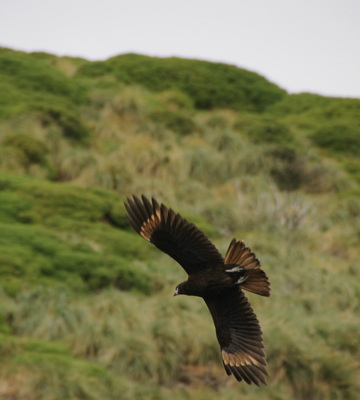
Striated Caracara at Terhalten Island, where the Beagle
Channel meets the Atlantic Ocean. |
This was no pre-paid vacation, though -- it was an adventure. By
half way through the trip, half of us were falling ill with Amos's
parting gift of a cold. I spent half the trip snorkeling
instead of diving because I couldn't clear my ears. Our wreck dive
ended with a most horrendous exit out of the water, during which the
crew learned how to help divers out of the water in choppy seas
(they'd never worked on a dive boat). Every 24 hours, the plans
changed. Crossing the border from Chile back to Argentina, we
discovered that Wolf had failed to go through customs on the way in,
resulting in a couple of hours of pleading and waiting until the
customs officer finally signed the boat's paperwork at 2am.
By the end the 6 day voyage, we'd grown into a close-knit group.
Three of the men shed a few tears upon parting.
|
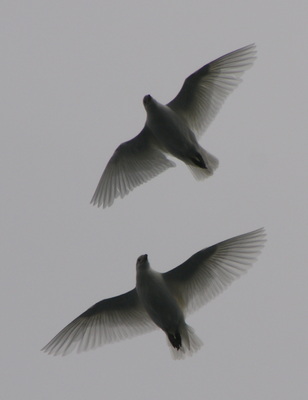
Snowy Sheathbills near Terhalten Island. |
It was a good trip -- but we'll go to Antarctica yet!
Photos, copyright 2008 Seth LaForge and Ania Mitros. Text by Ania.
Last updated 4 April 2008
© Anna Mitros
Back to Ania's Home Page
|